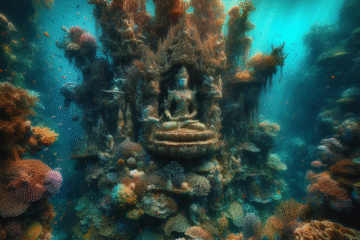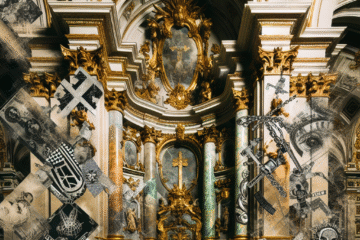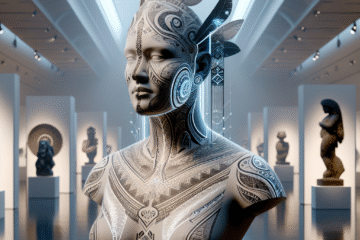Introduction
Art has always been an essential part of human culture and history. From the earliest cave paintings to contemporary abstract expressionism, art has served various purposes, including documenting human experiences, expressing emotions, and questioning societal norms. However, art’s benefits extend beyond aesthetics and entertainment. Art can help individuals grow as people by promoting creativity, problem-solving skills, empathy, and mindfulness. In this article, we will explore how art can help individuals develop and mature.
In today’s fast-paced, technology-driven world, it is crucial to find ways to cultivate personal growth and self-awareness. Engaging with art can be an effective tool to achieve this. Artistic practices such as painting, writing, dancing, or even simply viewing art can foster self-expression, self-reflection, and emotional regulation. Additionally, art’s potential to build empathy and mindfulness can help individuals develop a deeper understanding of themselves and others.
Therefore, it is essential to recognize the value of art in personal development and explore its potential to facilitate growth. Through this article, we will delve into the ways that art can be used as a means for self-exploration and transformation, ultimately leading to a more fulfilling and enriching life.
II. Art and Personal Growth
Art has long been associated with personal growth and self-discovery. From ancient civilizations’ cave paintings to modern-day street art, art has always served as a means of self-expression, communication, and reflection. Engaging with art can be a powerful tool for personal growth and development, helping individuals cultivate self-awareness, emotional regulation, and a greater sense of purpose.
One of the primary ways that art can promote personal growth is through self-expression. Through art, individuals can communicate their thoughts, feelings, and experiences in a way that may not be possible through verbal communication. Artistic practices such as painting, drawing, or writing can help individuals express themselves more freely, facilitating the release of repressed emotions and facilitating personal growth. For example, a person struggling with anxiety may find solace in creating abstract paintings, allowing them to process and express their emotions visually.
Art can also promote personal growth by encouraging self-reflection. Engaging with art can help individuals explore their inner thoughts and feelings, facilitating self-awareness and personal growth. For example, a person viewing a painting may identify with its themes or symbols, prompting them to reflect on their own experiences and emotions. Similarly, writing or journaling can help individuals reflect on their thoughts and feelings, leading to a greater understanding of oneself and ultimately facilitating personal growth.
Another way that art can promote personal growth is through emotional regulation. Engaging with art can be a powerful tool for managing emotions, reducing stress, and improving overall mental health. For example, creating art can provide a sense of control and mastery, helping individuals cope with anxiety and depression. Similarly, viewing art can be a soothing and meditative experience, promoting relaxation and emotional regulation.
In summary, art can be a powerful tool for personal growth, facilitating self-expression, self-reflection, and emotional regulation. Whether through creating or experiencing art, individuals can explore their inner selves, fostering self-awareness, and ultimately leading to personal growth and development.
III. Creativity and Problem Solving
Artistic practices are inherently creative, requiring individuals to think outside the box and come up with innovative solutions. This creativity can also be applied to problem-solving in everyday life, making art an effective tool for personal growth and development. Creativity and problem-solving are linked, and engaging in artistic practices can help individuals develop these skills, leading to personal growth and development.
One of the ways that creativity is linked to personal growth is through the development of problem-solving skills. Artistic practices require individuals to find new solutions to creative challenges, encouraging them to think outside the box and approach problems from different angles. For example, a painter may experiment with new techniques or materials to achieve a particular effect, while a writer may explore different plotlines or character development strategies to enhance their work. These skills can be transferred to other areas of life, such as work or personal relationships, facilitating personal growth and development.
Additionally, artistic practices can develop problem-solving skills by promoting resilience and persistence. Creating art requires a great deal of trial and error, with many pieces requiring multiple drafts or revisions. This iterative process can help individuals develop resilience and persistence, encouraging them to persist in the face of obstacles and setbacks. These skills can be applied to other areas of life, such as work or personal relationships, leading to personal growth and development.
Artistic practices can also develop problem-solving skills by promoting divergent thinking. Divergent thinking involves generating multiple possible solutions to a problem, encouraging individuals to explore different options and approaches. This type of thinking is essential for creativity and is often required in problem-solving situations. For example, a sculptor may explore different forms or materials for a particular project, while a musician may experiment with different chord progressions or harmonies. These skills can be applied to other areas of life, such as work or personal relationships, facilitating personal growth and development.
In summary, artistic practices can develop problem-solving skills by promoting resilience, persistence, and divergent thinking. These skills can be applied to other areas of life, leading to personal growth and development. Through engagement in creative endeavors, individuals can develop their creativity and problem-solving skills, facilitating personal growth and development.
IV. Art and Empathy
Art has the unique ability to connect people and foster understanding and empathy. By exposing individuals to different perspectives and experiences, art can facilitate personal growth and development, promoting empathy and understanding. In this section, we will explore the role of art in building empathy and understanding, as well as how experiencing different perspectives through art can lead to personal growth.
One of the primary ways that art builds empathy is through exposure to diverse perspectives and experiences. Artistic practices such as literature, film, and visual art can expose individuals to different cultures, values, and experiences, fostering understanding and empathy. For example, reading a novel set in a different country or culture can help individuals develop a deeper understanding of that culture, promoting empathy and compassion. Similarly, viewing art from different historical periods or cultures can help individuals appreciate and understand the experiences of others, leading to personal growth and development.
Art can also build empathy by humanizing individuals and experiences. Through artistic practices such as portraiture or narrative art, individuals can be represented in a way that humanizes them, making them relatable and understandable to others. This representation can promote empathy and understanding, helping individuals develop a deeper understanding of themselves and others. For example, a painting of a homeless person can help viewers understand the struggles of homelessness and foster empathy for those experiencing it.
Experiencing different perspectives through art can also lead to personal growth by challenging individuals’ assumptions and biases. By exposing individuals to different perspectives and experiences, art can challenge preconceived notions and promote personal growth and development. For example, a film that explores a controversial issue can challenge individuals’ beliefs and biases, prompting self-reflection and personal growth.
In summary, art can promote empathy and understanding by exposing individuals to diverse perspectives and experiences, humanizing individuals and experiences, and challenging assumptions and biases. Through engagement with art, individuals can develop a deeper understanding of themselves and others, promoting personal growth and development.
V. Art and Mindfulness
Mindfulness is a state of being present in the moment, focusing one’s attention on the present experience without judgment or distraction. Artistic practices such as painting, drawing, and writing can promote mindfulness by engaging individuals in a state of focused attention and concentration. In this section, we will explore how art can help promote mindfulness and provide examples of how creating or experiencing art can cultivate a state of mindfulness.
One of the primary ways that art can promote mindfulness is by engaging individuals in a state of focused attention. Artistic practices require individuals to focus their attention on the present moment, engaging in the creative process without distraction. This focused attention can promote mindfulness, allowing individuals to be present in the moment and fully engaged in the creative process. For example, a painter may focus their attention on the brush strokes, colors, and textures of their painting, becoming fully engaged in the present moment and promoting mindfulness.
Art can also promote mindfulness by providing an outlet for self-expression and emotional regulation. Creating art can be a cathartic and emotional experience, allowing individuals to express themselves freely and process their emotions. This emotional regulation can promote mindfulness by allowing individuals to be present in the moment and fully engaged in the creative process. For example, a writer may use writing as a means of processing and expressing their emotions, becoming fully engaged in the present moment and promoting mindfulness.
Engaging with art can also be a meditative and relaxing experience, promoting mindfulness and reducing stress and anxiety. Creating or experiencing art can provide individuals with a sense of calm and relaxation, allowing them to focus their attention on the present moment and promote mindfulness. For example, listening to music or viewing art can be a soothing and meditative experience, promoting relaxation and mindfulness.
In summary, art can promote mindfulness by engaging individuals in a state of focused attention, providing an outlet for self-expression and emotional regulation, and promoting relaxation and stress reduction. Through engagement with art, individuals can develop mindfulness skills, allowing them to be fully present in the moment and promote personal growth and development.
VI. Conclusion
Throughout this article, we have explored the various ways that art can be used as a valuable tool for personal growth and development. From promoting self-expression and emotional regulation to developing problem-solving skills and fostering empathy and mindfulness, art can have a profound impact on individuals’ personal growth and development.
We began by discussing how art can promote personal growth by facilitating self-expression, self-reflection, and emotional regulation. Engaging with art can help individuals explore their inner selves, fostering self-awareness and ultimately leading to personal growth and development.
Next, we explored how artistic practices can develop problem-solving skills by promoting resilience, persistence, and divergent thinking. These skills can be applied to other areas of life, such as work or personal relationships, leading to personal growth and development.
We then discussed the role of art in building empathy and understanding, promoting exposure to diverse perspectives and experiences, and humanizing individuals and experiences. Experiencing different perspectives through art can lead to personal growth by challenging individuals’ assumptions and biases.
Finally, we explored how art can promote mindfulness by engaging individuals in a state of focused attention, providing an outlet for self-expression and emotional regulation, and promoting relaxation and stress reduction. Through engagement with art, individuals can develop mindfulness skills, allowing them to be fully present in the moment and promote personal growth and development.
In conclusion, engaging with art can be a valuable tool for personal growth and development. Artistic practices can promote self-expression, emotional regulation, problem-solving skills, empathy, and mindfulness, ultimately leading to a more fulfilling and enriching life. By recognizing the value of art in personal development, individuals can harness its potential to facilitate growth and transformation, leading to a more self-aware, empathetic, and mindful society.


